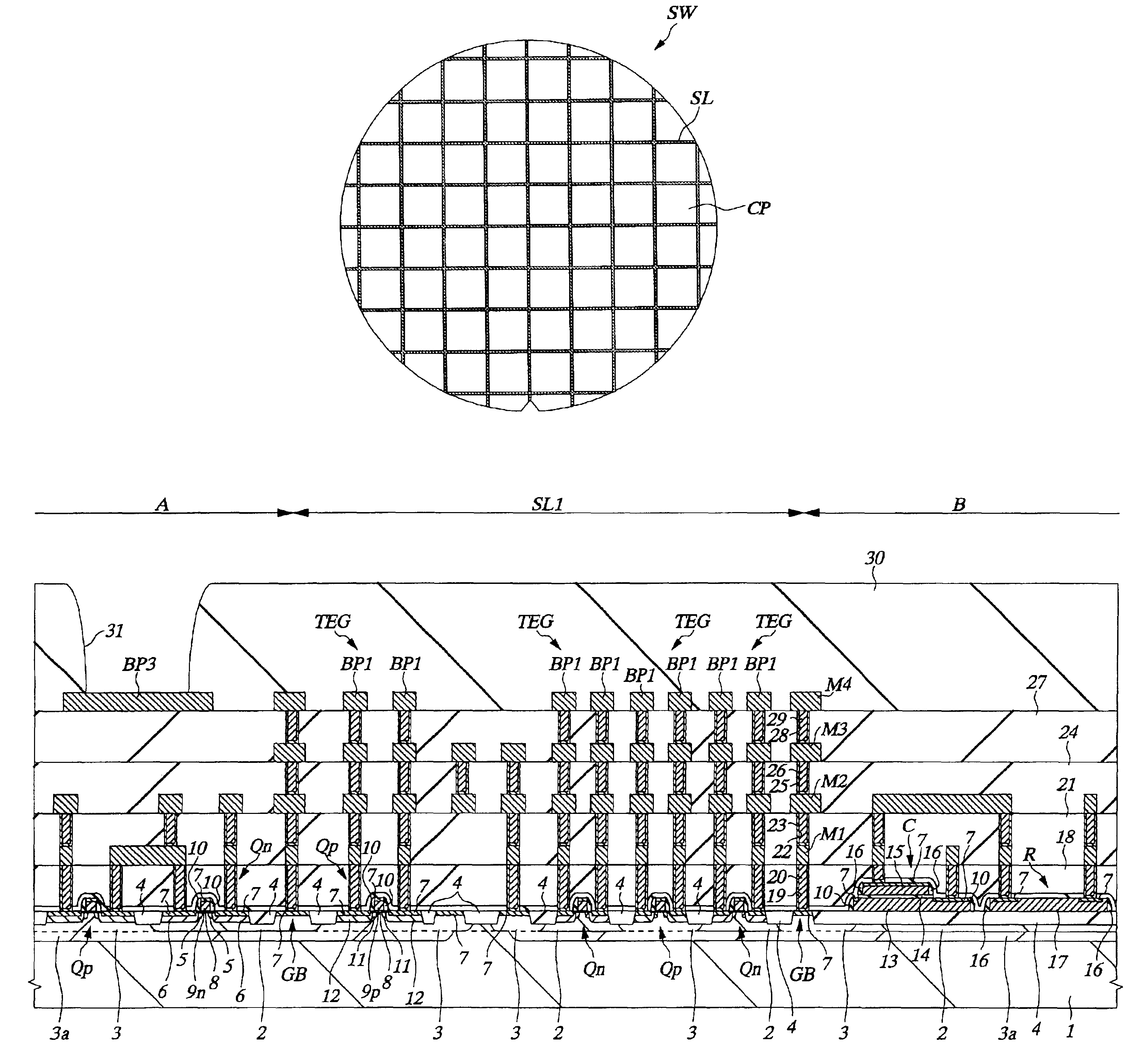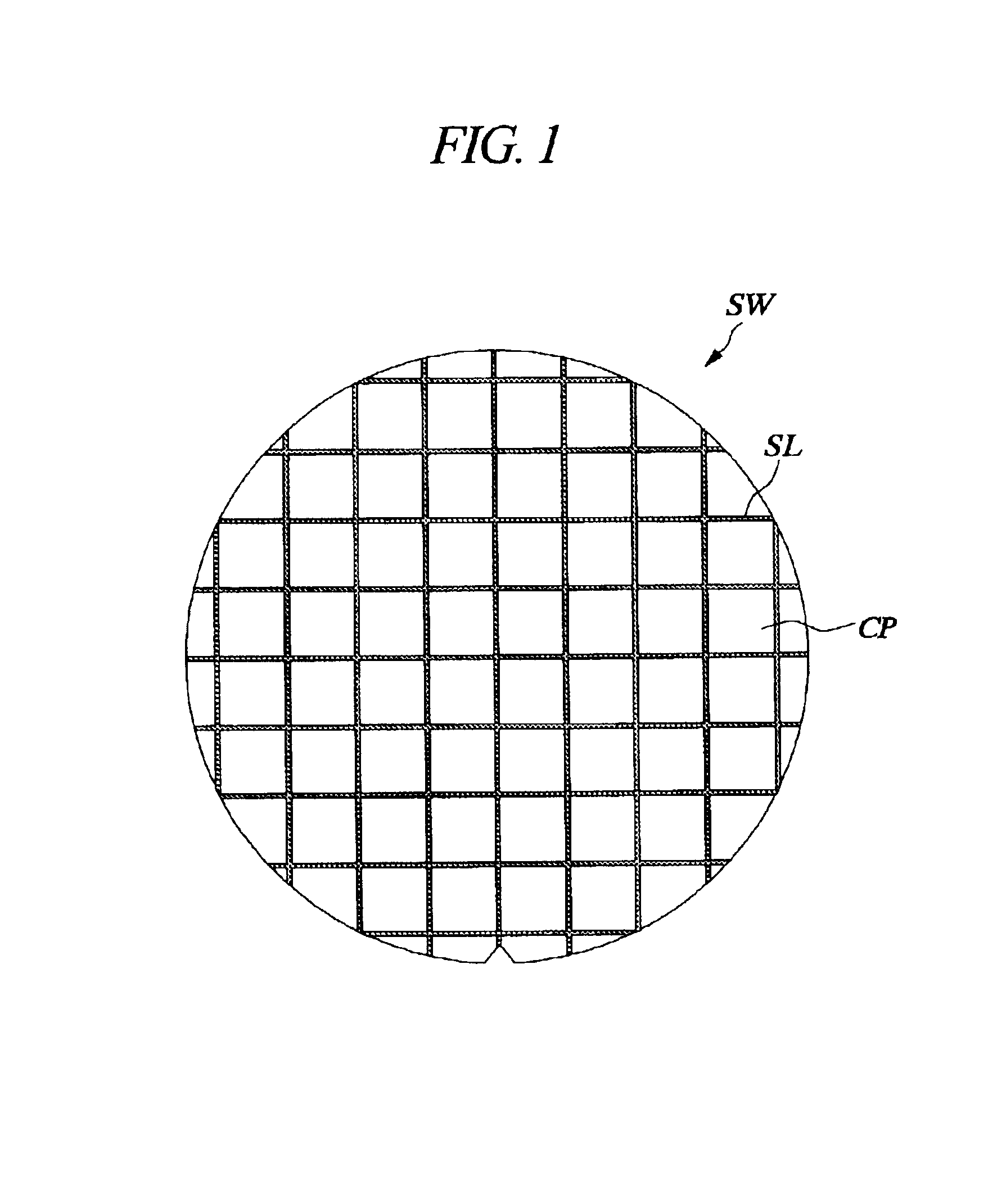Method of manufacturing a semiconductor device to provide a plurality of test element groups (TEGs) in a scribe region
- Summary
- Abstract
- Description
- Claims
- Application Information
AI Technical Summary
Benefits of technology
Problems solved by technology
Method used
Image
Examples
first embodiment
(First Embodiment)
[0078]FIG. 1 shows a scribe region SL on a wafer SW.
[0079]A chip CP on which a semiconductor integrated circuit is manufactured is not created separately one by one, but several tens of or hundreds of them are simultaneously manufactured together on one wafer SW, and then the wafer is divided into each of the chips CP. A step for dividing the wafer SW into each of the chips CP is called a dicing or a scribing, in which the wafer SW is completely cut by a circular cutting blade having a width of about 50 μm and rotating at a high speed. The region used in the abovementioned cutting is a scribe region (represented by a half-tone dot meshing in FIG. 1), which has a width of, for example, about 100 μm.
[0080]Guard bands functioning to prevent the water from permeating into the semiconductor integrated circuit are formed around the semiconductor integrated circuit, and the region sandwiched between the adjacent guard bands can be taken as a scribe region SL. As described...
second embodiment
(Second Embodiment)
[0152]In the foregoing first embodiment, descriptions have been made for the TEG provided with the first electrode pad BP1 which is a rectangular electrode having a side length of 0.5 μm or shorter and the TEG provided with the second electrode pad BP2 which is a rectangular electrode having a side length of 20 μm or longer. In this second embodiment, however, descriptions will be made for a TEG provided with both of the first electrode pad BP1, which is a rectangular electrode having a side length of 0.5 μm or shorter, and the second electrode pad BP2, which is a rectangular electrode having a side length of 20 μm or longer.
[0153]FIG. 19 is a plan view showing an example of the principal part of a plurality of TEGs and electrode pads arranged in a third scribe region SL3.
[0154]The TEG constituted of the MISFET is shown in the third scribe region SL3 as an example. The first electrode pad BP1 (represented by a half-tone dot meshing in FIG. 19) is a minute rectangu...
third embodiment
(Third Embodiment)
[0160]Descriptions will be made for the characteristic evaluation or the failure analysis of an actual device of a semiconductor product using a nanoprobe according to the third embodiment. A CMOS inverter circuit that is one of the basic logic circuits shown in FIG. 22 is exemplified as the actual device, and the measuring method of a logic value thereof will be described. FIG. 22A is a circuit diagram of a CMOS inverter circuit, and FIG. 22B is a perspective view showing the principal part of a semiconductor substrate illustrating an n channel MISFET Qn and a p channel MISFET Qp constituting the CMOS inverter circuit. In FIG. 22B, an example where a nanoprobe is contacted to an extraction electrode constituted of a first wiring layer is shown. In the case of a multi-layered wiring, however, the nanoprobe can be contacted to an extraction electrode constituted of the uppermost layer wiring of the two or more wiring layer. In FIG. 22B, the reference symbol SUB deno...
PUM
 Login to View More
Login to View More Abstract
Description
Claims
Application Information
 Login to View More
Login to View More - R&D
- Intellectual Property
- Life Sciences
- Materials
- Tech Scout
- Unparalleled Data Quality
- Higher Quality Content
- 60% Fewer Hallucinations
Browse by: Latest US Patents, China's latest patents, Technical Efficacy Thesaurus, Application Domain, Technology Topic, Popular Technical Reports.
© 2025 PatSnap. All rights reserved.Legal|Privacy policy|Modern Slavery Act Transparency Statement|Sitemap|About US| Contact US: help@patsnap.com



